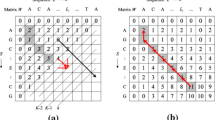Abstract
The length of the longest common subsequence (LCS) between two strings of M and N characters can be computed by O(M × N) dynamic programming algorithms that can execute in O(M+N) on a linear systolic array. If the strings are run-length encoded, LCS can be computed by an O(mN+Mn–mn) algorithm, called RLE-LCS, where m and n are the numbers of runs of the two strings.
In this paper we propose a modified RLE-LCS algorithm mappable on a linear systolic array.
Access this chapter
Tax calculation will be finalised at checkout
Purchases are for personal use only
Similar content being viewed by others
References
Smith, T.F., Waterman, M.S.: Identification of common molecular subsequences. Journal of Molecular Biology 48, 195–197 (1981)
Lopresti, D.: P-NAC: A Systolic Array for Comparing Nucleic Acid Sequences. Computer 24(11), 6–13 (1987)
Sayoood, K., Fow, E. (eds.): Introduction to Data Compression, 2nd edn. Morgan Kaufmann, San Francisco (2000)
Freschi, V., Bogliolo, A.: Longest Common Subsequence between Run-Length-Encoded Strings: a New Algorithm with Improved Parallelism. Information Processing Letters 90, 167–173 (2004)
Author information
Authors and Affiliations
Editor information
Editors and Affiliations
Rights and permissions
Copyright information
© 2004 Springer-Verlag Berlin Heidelberg
About this paper
Cite this paper
Bogliolo, A., Freschi, V., Miglioli, F., Canella, M. (2004). FPGA-Based Parallel Comparison of Run-Length-Encoded Strings. In: Becker, J., Platzner, M., Vernalde, S. (eds) Field Programmable Logic and Application. FPL 2004. Lecture Notes in Computer Science, vol 3203. Springer, Berlin, Heidelberg. https://doi.org/10.1007/978-3-540-30117-2_137
Download citation
DOI: https://doi.org/10.1007/978-3-540-30117-2_137
Publisher Name: Springer, Berlin, Heidelberg
Print ISBN: 978-3-540-22989-6
Online ISBN: 978-3-540-30117-2
eBook Packages: Springer Book Archive




